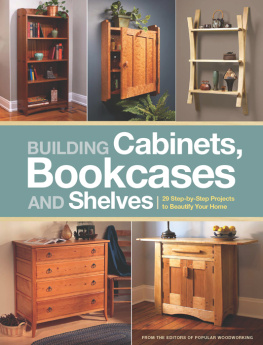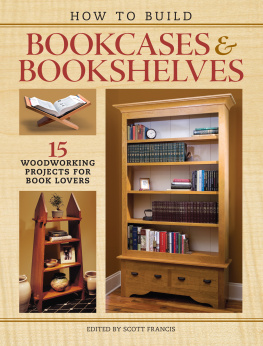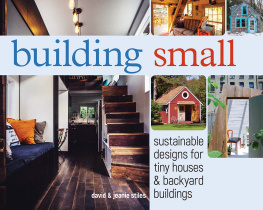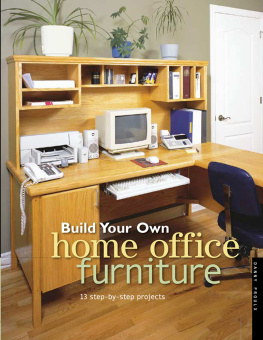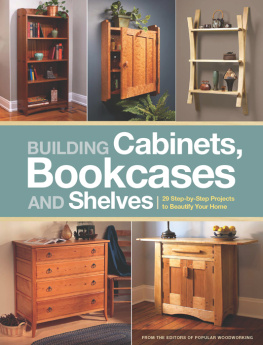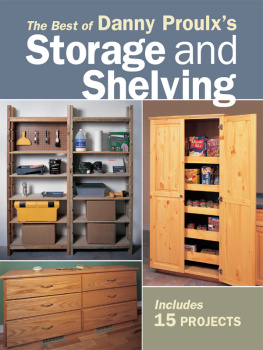Sign up for our newsletter and receive special offers, access to free content, and information on the latest new releases and must-have woodworking resources! Plus, receive a coupon code to use on your first purchase from ShopWoodworking.com for signing up.
Introduction
Im not sure of the date when humans moved from hunter/gatherers to an agrarian society, but Im pretty sure it was about that same time that we started bringing things into the cave or hut and started storing them. Whether for temporary storage, or because we needed to know where something was the next time we needed it, weve been storing items in our homes for thousands of years. Thats not a bad thing, unless hoarding is an issue. Thats where this book comes in. That may be an oversimplification, but lets say that by building furniture to store our items, were successfully limiting ourselves to only store what we have space for unless we build more.
Regardless, this book is about celebrating our human nature for storage. The projects in this book fit into two largers categories of storage: open or enclosed. There are cabinets for storing the items that dont need to be displayed, and there are shelves for those items that we want to share with others, or just need available for easy access. And there are a few projects that dont fit perfectly into either category, but I know well find things to store in them.
The projects range in skill level from some very simple furniture pieces requiring very basic skills and only a few tools, to other projects that are best attempted by those with some woodworking experience under their toolbelt. Either way, weve provided step-by-step instructions, cutting lists and diagragms that should make every project approachable to the average builder.
While each of the projects offer instruction to build exactly as shown, we encourage you to step outside your comfort zone and customize the projects as you see fit. Lets face it, we dont all live in the same size house, or have the same size items to store. Feel free to adjust the project to better fit your needs.
Along those same lines, the projects in this book represent a number of different furniture styles. You may find a bookcase that is the right proportion for what you want, but Arts & Crafts isnt your thing. Again, customize as you see fit. Style is usually a function of a couple of design details that can be switched between pieces to best match your furniture style.
Lastly, have fun, and be safe. Plan out your project and the steps involved and things will go much smoother.
DAVID THIEL, EDITOR

PROJECT
Arts & Crafts Buffet
BY ROBERT W. LANG
I designed this buffet cabinet a couple years ago for a weekend seminar on Arts & Crafts joinery. After the class I added a 3-D model to the Popular Woodworking Magazine online SketchUp collection. It was an easy way to provide detailed plans for those in attendance. As time passed, the model rose to the top of the collection, based on popularity.
My goal in designing it was to combine several classic elements from the early 20th century, without building a reproduction of any one piece in particular. I was looking to design a piece with a contemporary feel, but that was grounded in traditional Arts & Crafts period elements. Apparently I swiped the right details from the right sources to make a successful piece.
The wide overhanging top with breadboard ends, the finger-jointed drawer and the sculpted handles were all borrowed from the designs of Charles and Henry Greene. The proportions of the door stiles and rails were lifted right from the Gustav Stickley stylebook, and the double-tapered legs are a Harvey Ellis element turned upside down.
Equally important are the overall proportions and the rounded edges that ease the transitions where there is a change of direction or a change in plane. The light color of the soft maple keeps the cabinet from looking too formal or too masculine. Absent are the elements often seen in new pieces based on old designs. Corbels and spindles were banished to the land of overused and misapplied design features.
Skinny Legs & All
The legs are important visually; the upward taper leads the eye to the top, and the wide portion near the bottom makes the base appear substantial. Combined with the wide rails on the bottom of the doors, the case sits on a firm visual foundation, and it looks larger and heavier than it really is.
The legs are also key elements in the structure. Each leg is a corner for two different frames. There is a lot of joinery in each, and to help keep track of the leg locations, I laid out the tapers after resawing the legs from 8/4 stock. My local supplier didnt have material available simply to mill the legs to the 1 finished dimension, so I bought thicker than I needed, resawed the boards to 1 and saved the thin offcuts for the bottom of the drawer.
My method is to work out all the joinery first, then cut pieces to shape and round the edges just before final assembly. I cut the -wide stopped grooves for the side and back panels first, using a plunge router. I then lowered the depth setting and cut the mortises in the wide faces of the legs with the same router.
There isnt enough of a flat area on the narrow sides of the legs to support the router, so I moved to the hollow-chisel mortiser to add the mortises for the front and back rails. Then I cut the tenons on the ends of the top and bottom side rails. I used a backsaw for the shoulder cuts, then cut the cheeks on the band saw.
I dry-fit the side rails to the legs, forming side sub-assemblies without panels. Then I made the joints for the front and back rails. In the back, the mortises fall within the grooves for the back panel. In the front of the case, the mortises are the only joinery.
To keep the backs of the front and back rails flush with the back of the legs, I set my marking gauge directly to the edge of a mortise. Then I used that setting to mark out the tenons. I cut the tenon shoulders with my backsaw and the cheeks on the band saw. After fitting these joints, I did another dry run, connecting the two side assemblies with the front and back rails.
Come Together
With a complex piece such as this, the best way to ensure that everything fits together is to make careful dry runs, then pull the actual dimensions for the next piece to be fabricated from the subassembly. With the legs connected side to side and front to back, I made sure the carcase was square before making the bottom.
The bottom fits between the front and back rails, and at the ends there is a pair of through-tenons. The critical distance is from shoulder to shoulder on these tenons. After ripping the bottom to width, I held the bottom in place below the rails on the carcase and marked the shoulder locations directly.

